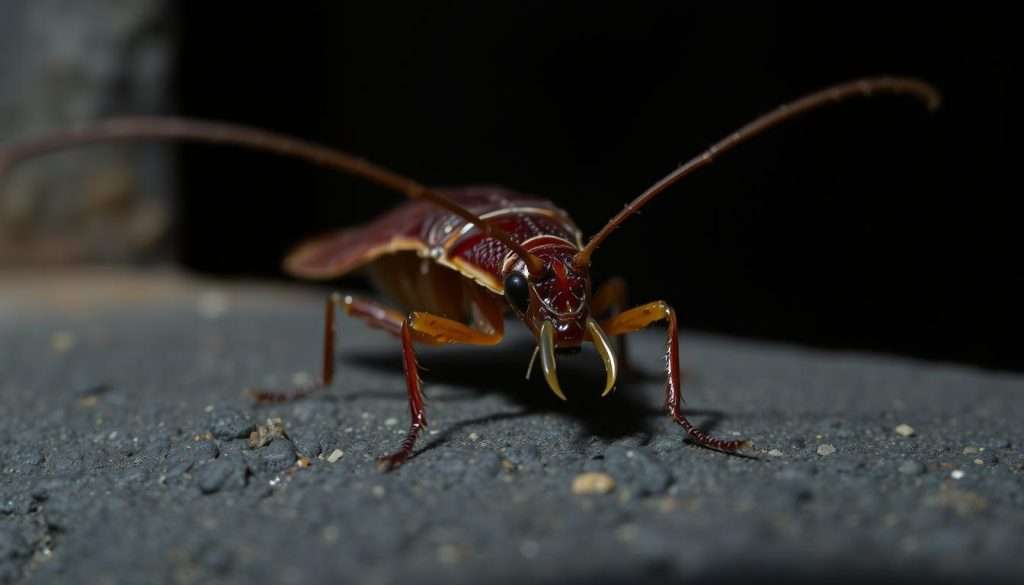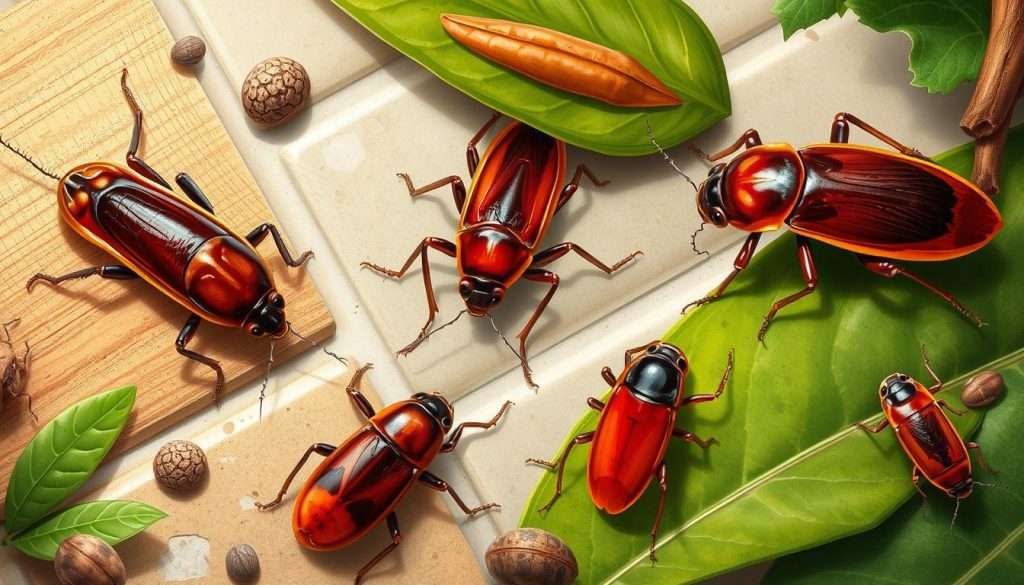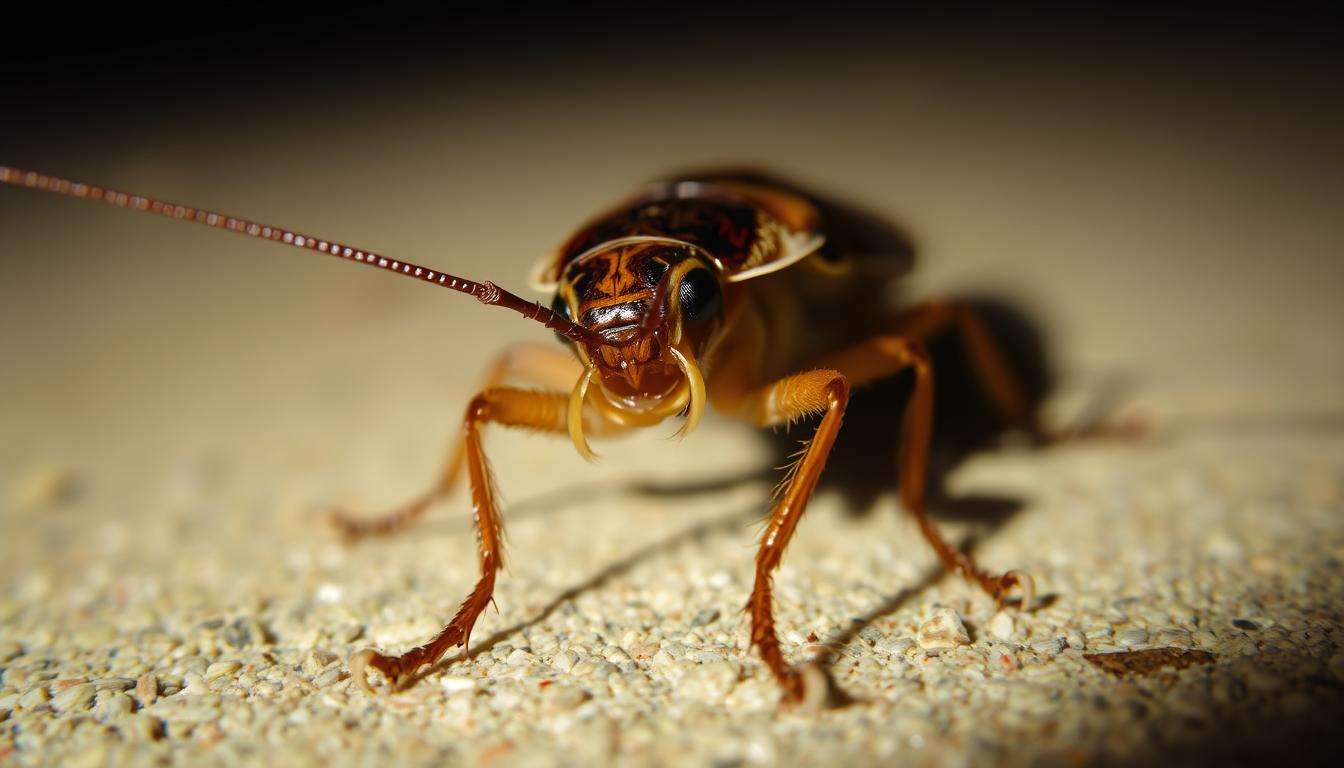Thinking about cockroach bites in our homes can be scary. But, it’s important to know the truth about cockroach behavior. Cockroaches might get a bad rap, but getting bitten by them is rare. It’s much more likely to get bitten by bees or spiders.
Most cockroach bites happen when people are asleep at night. This is because roaches look for food when it’s dark. Their bites look like red dots, similar to bed bug bites. But, these bites are not common and usually happen when homes are dirty.
In this article, we’ll dive into the world of cockroaches. We’ll talk about bites, their behavior, and how to keep your home safe from them.
Key Takeaways
- Cockroach bites are rare but may occur in large infestations.
- Typically, bites happen at night while people sleep and are searching for food traces.
- Bites appear as small, raised red bumps, similar to bed bug bites, and can be itchy.
- Maintaining cleanliness is crucial in preventing cockroach infestations and associated bites.
- Cockroaches are not known disease vectors, but their bites can lead to infections.
Introduction to Cockroach Behavior
Cockroaches are fascinating and very resilient. They are mostly active at night, using darkness to find food. They eat a wide variety of things, including waste and non-food items.
They can live in many places, like homes, kitchens, and bathrooms. This is because they can adapt well to different environments.
Knowing how cockroaches behave is key to controlling them. They like warm, moist places and hide where people don’t go. In Florida, up to 90% of homes have cockroaches at some time.
They prefer dark spots to stay hidden from humans. Keeping areas clean and tidy helps keep them away. Spotting signs of infestation early helps take action fast, keeping your home cockroach-free.
The Myth of Cockroach Bites
Many people think cockroaches bite often. But, cockroaches mostly stay away from humans. They like rotting stuff more than living things. So, getting bitten by a cockroach is very rare.
Reports of cockroach bites are rare. They happen when cockroaches are very hungry or crowded. Cockroaches can bite, but it’s not common. Their bites look like other insect bites and are usually from exploring, not attacking.
Bites might itch, especially for people with allergies. But, they’re not usually harmful. The main worry is if you scratch the bite and it gets infected. Cockroaches don’t spread diseases through bites. But, they can carry allergens and bacteria that might cause problems like asthma or stomach issues.
To avoid cockroach bites, keep your place clean. Here’s how:
- Seal food well and store it right
- Take out the trash often
- Block their hiding spots
If cockroaches keep coming back, get help from pest control experts. They can get rid of cockroaches and help keep them away.
Can a Cockroach Bite: Understanding the Circumstances
Cockroaches might bite in certain situations for cockroach bites, but it’s rare. Knowing when and why they bite helps us feel safer. They bite when food is hard to find or when there’s a big infestation.
Factors Leading to Cockroach Bites
Several factors leading to cockroach bites include:
- Sparse Food Supply: When food is scarce, cockroaches might come closer to humans for food.
- Overcrowded Conditions: When there are too many roaches, they fight for food, leading to bites.
- Nocturnal Activity: Roaches are active at night. They might bite people while they’re sleeping.
Cockroaches don’t bite to defend themselves. Their mouthparts can’t really bite humans. But, in extreme hunger, they might nibble on nails or tough skin.
Situations When Bites May Occur
The situations for cockroach bites often happen in the dark, near food:
- Bites usually happen on hands, feet, eyelashes, and fingernails, often when asleep.
- A person might feel a sharp pinch during the bite, but it goes away fast.

Even though bites can happen, there’s no need to be too scared. Keeping things clean and getting rid of big infestations helps a lot. For more on what bites look like, check out this guide.
Cockroach Anatomy and Feeding Habits
Cockroaches have interesting bodies that help them survive and eat. Knowing about their anatomy, especially their mouthparts, shows how they find and eat food.
Mouthparts and Their Functionality
The mouthparts of cockroaches are made for finding and eating food. They have mandibles that help them grind food. They can bite, but it’s not common.
Mostly, they use their mouthparts to break down food, not to bite people.
Dietary Choices of Cockroaches
Cockroaches eat almost everything. Their diet includes:
- Starchy foods
- Sweets
- Greasy substances
- Decaying plant and animal matter
When food is scarce, they might eat things like paper or hair. They only bite when they feel threatened. But this doesn’t happen often.
| Aspect | Details |
|---|---|
| Cockroach Mouthparts | Designed for grinding, not piercing. |
| Diet | Omnivorous, includes a variety of materials. |
| Biting Behavior | Rarely bites unless feeling threatened. |
| Food Sources | Starches, sweets, grease, organic decay. |
Knowing how they eat helps us keep cockroaches away. This makes our homes safe and cozy.
Health Risks Associated with Cockroach Bites
Cockroach bites can be a problem for some people. Knowing how to spot these bites and the risks of infection helps manage them better.
Appearance and Symptoms of Bites
Cockroach bites look like small red bumps. They can be confused with other bug bites. These bites might cause swelling and rashes that last for days.
Some people might get allergic reactions. This can lead to itching or irritation. It’s important to know what these bites look like to get the right treatment.
Infection Risks from Cockroach Exposure
Cockroaches carry harmful germs like salmonella and polio virus. These germs can get into bite wounds. This is a big risk if not treated right away.
Getting bitten by a cockroach can also make breathing hard for some. This is especially true for people with asthma. Knowing these risks helps homeowners stay healthy.
| Risk Factor | Description | Health Impact |
|---|---|---|
| Skin Reactions | Red bumps, swelling, and rashes | Can persist for days affecting comfort |
| Allergic Reactions | Triggers asthma attacks and skin irritation | Worsens respiratory conditions |
| Infection Risks | Potential transfer of pathogens | Increases risk of severe health issues |
| Contamination | Presence of bacteria from cockroach bodies | Overall hygiene decline in living spaces |
Common Species and Their Behavior
Knowing how different cockroach species behave is key to controlling pests. German and Oriental cockroaches are common. They have unique traits and habits that affect how they interact with people.
German Cockroaches
German cockroaches are common in homes, especially in North America. They are small, about 1.1 to 1.6 inches long. They are mostly active at night, looking for food and water.
- Development: German cockroaches grow up in about 10 weeks. A female can have up to 350 babies.
- Diet: They eat food scraps, pet food, and even dead skin. This is why they like kitchens and pantries.
- Biting Behavior: Bites are rare but can happen in big infestations. They can cause small red spots that might scab over.
Oriental Cockroaches
Oriental cockroaches are bigger, about 1.1 to 3 inches long. They look like water bugs because of their dark, shiny skin. They like cooler, damp places, like basements and sewers.
- Habitat Preferences: They live in moist spots like drains and under appliances. They look for food and water.
- Feeding Habits: Oriental cockroaches eat many things. This can make food in kitchens dirty if they get in.
- Biting Potential: Bites are rare, but Oriental cockroaches might bite more when food is scarce.

Knowing the differences between cockroach species helps in fighting pests. Whether it’s German or Oriental cockroaches, knowing how to act can stop infestations.
How to Prevent Cockroach Infestations
To stop cockroaches, keep your place clean. This helps keep them away and keeps you healthy. Start by sealing food in tight containers. Also, throw away waste often and get rid of extra moisture in your home.
Sanitation and Cleanliness Practices
Good sanitation is key to avoiding cockroaches. Here are some steps to keep your place roach-free:
- Clean regularly, especially where you prepare food.
- Throw away food waste fast and use sealed bags for garbage.
- Clear out clutter to stop cockroaches from hiding.
- Fix leaks and get rid of standing water to avoid damp spots.
Effective Pest Control Strategies
Good pest control is also important. Here are some tips:
- Seal up cracks and crevices to keep roaches out.
- Use traps to catch any roaches you see.
- Check and fix places where pests might get in.
- If needed, call experts for a full treatment.
For more help on dealing with cockroach bites, check out this guide on cockroach bites. Keeping your home pest-free makes it more comfortable and healthier.
Cockroach Defense Mechanisms and Social Behavior
Cockroaches are amazing insects with many cockroach defense mechanisms. They can move fast and hide in small spaces. These skills help them avoid predators and stay alive. It’s impressive to see how well they adapt and survive.
The social behavior of cockroaches is also fascinating. They don’t live alone; they have a complex social life. They use pheromones to talk to each other. This lets them work together, share food, and warn each other of danger.
Knowing how cockroaches behave together helps us fight them better. Keeping your home clean and understanding their ways can help control them. It’s a smart way to manage pests.
| Aspect | Description |
|---|---|
| Speed | Ability to move quickly, evading threats efficiently. |
| Concealment | Skill to hide in tight spaces, providing safety from predators. |
| Pheromonal Communication | Use of chemical signals to coordinate behavior and share information. |
| Group Behavior | Ability to gather in groups for resource sharing and coordinated responses. |
Conclusion
Learning about cockroach behavior helps clear up many myths about bites. While bites can happen, they are rare. They usually occur when there’s too many cockroaches or not enough food.
Cockroaches rarely bite people. They prefer to find food in trash or open areas.
Keeping your place clean is key to avoiding cockroaches. Good sanitation and pest control can help a lot. Homeowners and DIY fans can keep their homes cockroach-free by sealing holes, using traps, and throwing away trash right.
Now you know more about cockroach bites and how they behave. You can make your home pest-free. Stay informed and keep your home clean to avoid cockroach problems.
